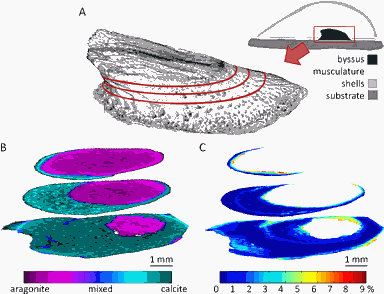Probing for biological polymorphs

(Phys.org) —Humans have devised many amazing and versatile materials (such as plastic and steel) that do not exist in nature. On the other hand, nature has created structures and substances that materials scientists and engineers can only envy. One example is the adhesive structures, or byssus, used by mussels, oysters, and barnacles to fasten themselves to surfaces.
The bivalve Anomia simplex, aka the common jingle shell, has a byssus that is partly organic and partly composed of polymorphic crystalline material. This complex byssus material is incredibly adhesive and strong even in conditions that degrade synthetic substances. Studying such polymorphic materials to determine the connections between the materials' design and function has been challenging because their components share highly similar absorption and refractive qualities that make them difficult to distinguish through conventional non-destructive x-ray techniques such as micro-computed tomography.
Now research at the U.S. Department of Energy Office of Science's Advanced Photon Source has mapped the aragonite and calcite polymorphs in the byssus of Anomia simplex. This work provides important clues to the underwater adhesion properties of the Anomia simplex byssus and demonstrates the value of diffraction tomography in the detailed study of complex materials.
The experimenters from Aarhus University (Denmark), Northwestern University, and Argonne National Laboratory examined Anomia simplex specimens at the X-ray Science Division 1-ID beamline of the Advanced Photon Source at Argonne. They utilized non-destructive x-ray diffraction tomographic methods to reconstruct the distribution of various crystalline phases in the material and determine the degree of local magnesium substitution through analysis of reconstructed powder diffractograms. The specimens were examined whole, without being cut or sectioned in any way.
The Anomia byssus is a highly calcified and complex structure, consisting of a lamellar section that interacts with the musculature and a more porous section that faces the hard surface. The lamellar section is composed of highly crystallized organic material sheets that extend both into the muscles and through the porous part of the byssus all the way to the attachment surface. The byssus begins in a young Anomia as a small lamellar organic plate that slowly mineralizes and increases in size as the animal grows, adding calcified support below.
The researchers collected both absorption and diffraction data simultaneously, obtaining maps with 50-µm resolution. They found that they were able to obtain much more valuable information from the diffraction tomography. The x-ray absorption studies showed macroscopic-scale features with little detail, while the diffraction studies allowed data-rich reconstructions using two different approaches, one examining specific regions of interest in particular diffraction angles consistent with different polymorphs, and the other generating full reconstructed powder diffractograms. The first approach demonstrated that the calcite and aragonite polymorphs were present in quite distinct areas of the byssus: aragonite solely in the lamella, calcite solely in the porous region.
The reconstructed powder diffraction data from the second approach showed the degree of magnesium substitution in the porous calcite areas, where magnesium can substitute into the calcite structure leading to shifts in its diffraction peaks. The investigators found bands of high magnesium content in the porous areas of the byssus, especially near the interface with the lamellar volumes.
They explain that two separate mechanisms could account for the presence of magnesium in the byssus. The first is structural adaptation due to increased mechanical stress (the presence of magnesium strengthens and stiffens the calcite structure of the byssus).
A second possibility is that seawater infiltrates the byssus and magnesium is thus incorporated into it as a byproduct of normal growth. This is supported by the discovery of a generally higher amount of magnesium near the interface between the lamellar and porous regions of the byssus, as magnesium cannot incorporate into the aragonite structure but will be pushed in front of the growth zone, giving an increased magnesium concentration at the interface. The investigators note that the question is still unresolved and bears further investigation.
The ability to map the relative distribution of polymorphs and local variations in the crystalline phases (here giving magnesium substitution in the Anomia byssus) demonstrated in this work provides an impressive example of the value of diffraction tomography in the detailed study of complex materials. Because these techniques are completely non-destructive both mechanically and from a radiation exposure standpoint, the same specimen can later be studied using different methods. Particularly in cases where such concerns are most important, as when dealing with biological specimens, this makes diffraction tomography an invaluable tool.
More information: Hanna Leemreize, Jonathan D. Almer, Stuart R. Stock, and Henrik Birkedal, "Three-dimensional distribution of polymorphs and magnesium in a calcified underwater attachment system by diffraction tomography," J.R. Soc. Interface 10(89), 20130319 (2013). DOI: 10.1098/rsif.2013.0319
Provided by Argonne National Laboratory



















